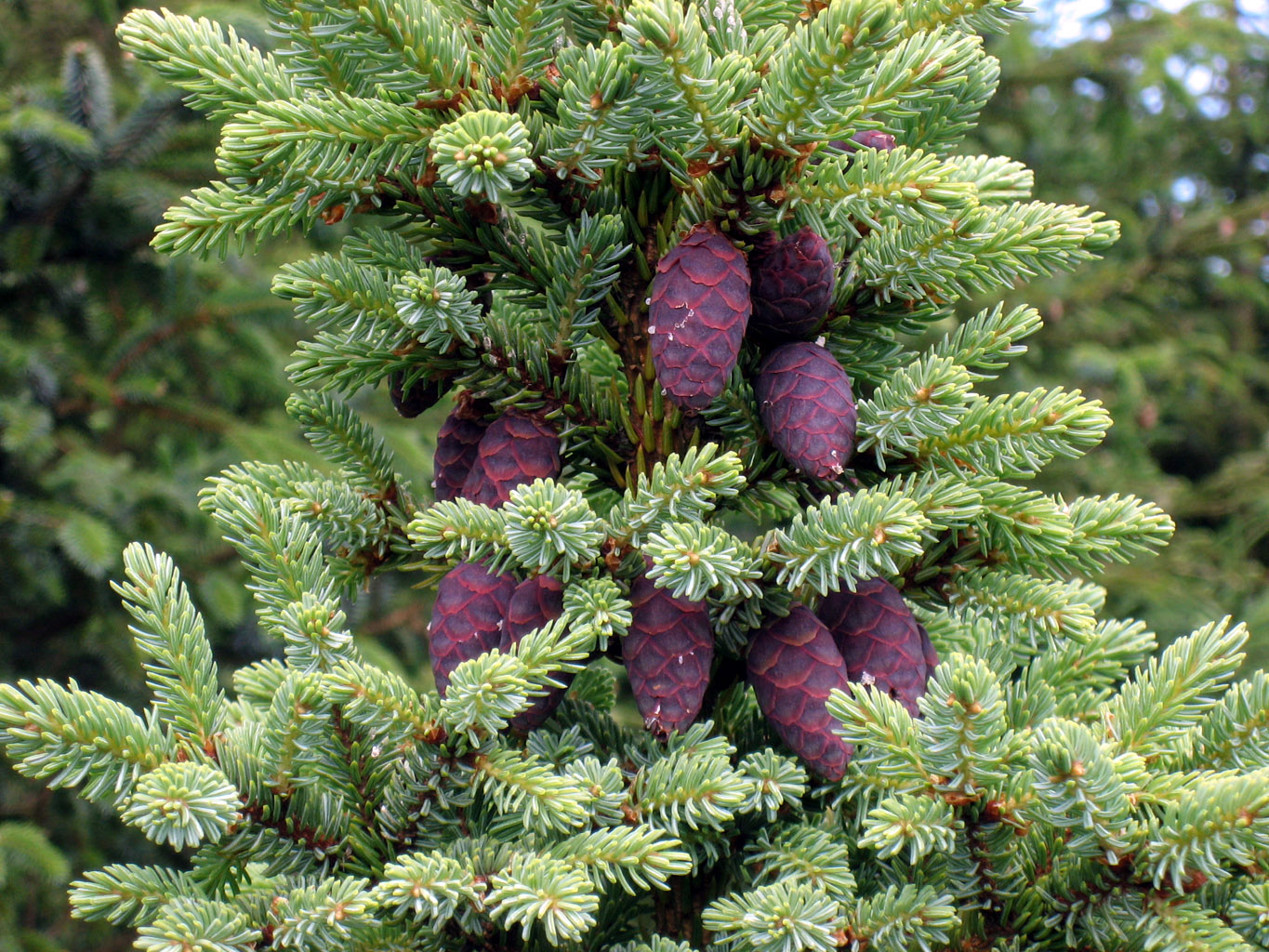- Picea mariana
Taxobox
name = "Picea mariana"
status = LR/lc | status_system = IUCN2.3

image_width = 240px
image_caption = Foliage and cones
regnum =Plant ae
divisio = [familia =
Pinaceae
genus = "Picea"
species = "P. mariana"
binomial = "Picea mariana"
binomial_authority = (Mill.) Britton, Sterns & Poggenburg"Picea mariana" (Black Spruce) is a species of
spruce native to northernNorth America , from Newfoundland west toAlaska , and south to northernNew York ,Minnesota and centralBritish Columbia . This area is also known as thetaiga forest.Farjon, A. (1990). "Pinaceae. Drawings and Descriptions of the Genera". Koeltz Scientific Books ISBN 3-87429-298-3.] Rushforth, K. (1987). "Conifers". Helm ISBN 0-7470-2801-X.] [IUCN2006|assessors=Conifer Specialist Group|year=1998|id=42328|title=Picea mariana|downloaded=12 May 2006] Gymnosperm Database: [http://www.conifers.org/pi/pic/mariana.htm "Picea mariana"] ] Flora of North America: [http://www.efloras.org/florataxon.aspx?flora_id=1&taxon_id=233500911 "Picea mariana"] ]It is a slow-growing, small upright
evergreen coniferoustree (rarely ashrub , having a straight trunk with little taper, a scruffy habit, and a narrow, pointed crown of short, compact, drooping branches with upturned tips. Through much of its range it averages 5-15 m tall with a trunk 15-50 cm diameter at maturity, though occasional specimens can reach 30 m tall and 60 cm diameter. Thebark is thin, scaly, and grayish brown. The leaves are needle-like, 6-15 mm long, stiff, four-sided, dark bluish green on the upper sides, paler glaucous green below. The cones are the smallest of all of the spruces, 1.5-4 cm long and 1–2 cm broad, spindle-shaped to nearly round, dark purple ripening red-brown, produced in dense clusters in the upper crown, opening at maturity but persisting for several years.Natural hybridization occurs regularly with the closely related "
Picea rubens " (Red Spruce), and very rarely with "Picea glauca " (White Spruce).It differs from "
Picea glauca " (White Spruce) in having shorter needles, smaller and rounder cones, and a preference for wetter lowland areas. From truefir s, such as "Abies balsamea " (Balsam Fir), it differs in having pendulous cones, persistent woody leaf-bases, and four-angled needles, arranged all round the shoots.Old synonyms include "Abies mariana, Picea brevifolia, Picea nigra".
Ecology
Growth varies with site conditions. In swamp and
muskeg it shows progressively slower growth rates from the edges toward the centre. The roots are shallow and wide spreading with fallen trees are colloquially called "drunken trees ", and are often associated with thawing ofpermafrost .It grows in both lowland and upland sites. In the southern portion of range it is found primarily on wet organic soils, but farther north its abundance on uplands increases. In the Lake States it is most abundant in peat bogs and swamps, also on transitional sites between peatlands and uplands. In these areas it is rare on uplands, except in isolated areas of northern Minnesota and the Upper Peninsula of
Michigan .Most stands are even-aged due to frequent fire intervals in Black Spruce forests. It commonly grows in pure stands on organic soils and in mixed stands on mineral soils. It is tolerant of nutrient-poor soils, and is commonly found on poorly drained acidic peatlands. It is considered a climax species over most of its range. However, some ecologists question whether Black Spruce forests truly attain climax because fires usually occur at 50-150 year intervals, while "stable" conditions may not be attained for several hundred years.
The frequent fire return interval perpetuates numerous successional communities. Throughout boreal North America,
Paper Birch "Betula papyrifera" and Quaking Aspen "Populus tremuloides" are successional hardwoods that frequently invade burns in Black Spruce. Black Spruce typically seeds in promptly after fire, and with the continued absence of fire, will eventually dominate the hardwoods.It is a pioneer that invades the sedge mat in filled-lake bogs, though often preceded slightly by
Tamarack Larch "Larix laricina", with which it may in time form a stable forest cover in swamps. However, as the peat soil is gradually elevated by the accumulation of organic matter, and the fertility of the site improves, Balsam Fir andEastern Arborvitae "Thuja occidentalis" will eventually replace Black Spruce and Tamarack.The larvae of the
Spruce Budworm moth cause defoliation and if it occurs several years in a row will lead to death, though Black Spruce is less susceptible than White Spruce or Balsam Fir. Trees most at risk are those growing with Balsam Fir and White Spruce.Uses and symbolism
Black Spruce is the Provincial tree of Newfoundland.
The
wood is of low value due to the small size of the trees, but is used for pulp and paper making.References
Wikimedia Foundation. 2010.
